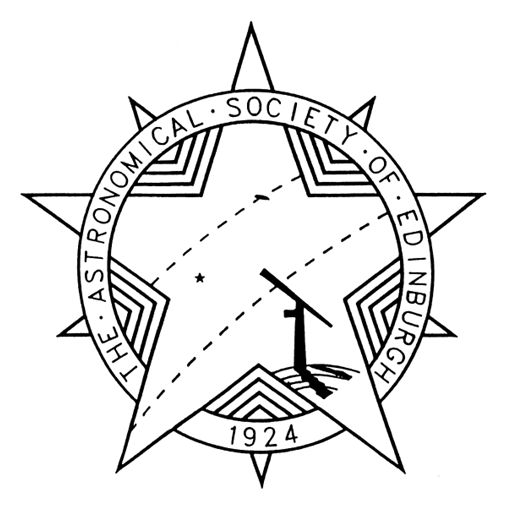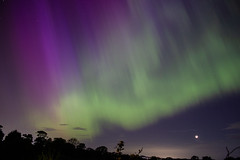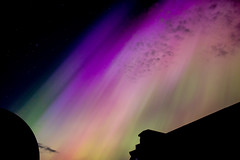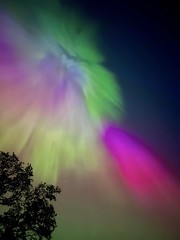Monthly Archives: June 2015
Scotland’s Sky in July, 2015
New Horizons to be first at dwarf planet Pluto

The maps show the sky at 01:00 BST on the 1st, midnight on the 16th and 23:00 on 31st. (Click on map to englarge)
Since our nights are still awash with summer twilight, we may be excused if our attention this month turns to Pluto as it is visited by a spacecraft for the first time.
Pluto was still regarded as a the solar system’s ninth planet when NASA’s New Horizons mission launched in 2006, but it was officially reclassified as a dwarf planet later that year. We now recognise it as one of several icy worlds, and not even the largest, in the Kuiper Belt of such objects beyond the orbit of Neptune.
Pluto is 2,368 km wide and has a system of five moons, two of them only discovered while New Horizons has been en route. The largest moon, Charon, is 1,207 km across and, like Pluto itself, will block the probe’s signal briefly as New Horizons zooms through the system at a relative speed of almost 14 km per second on the 14th. The closest approach to Pluto is due at 12:50 BST at a range of some 12,500 km from Pluto and 4,772 million km from the Earth. It will not hang around, though, since this is a flyby mission and the probe will speed onwards, perhaps to encounter another still-to-be-identified Kuiper Belt world before the end of this decade.
A conjunction of an altogether different type is gracing our western evening sky as July begins. The two most conspicuous planets have been converging over recent weeks and stand at their closest on the 1st when the brilliant Venus passes within 21 arcminutes, or two-thirds of a Moon’s breadth, of Jupiter.
On that evening, Venus is just below and left of Jupiter and sinks from 14° high in the west at sunset to set in the west-north-west about 100 minutes later. Shining at magnitude -4.4 from a distance of 76 million km, Venus appears 33 arcseconds in diameter and 33% illuminated, its dazzling crescent visible through a small telescope or even binoculars. Jupiter, 911 million km away on that evening, is 32 arcseconds wide but only one eleventh as bright at magnitude -1.8.
Over the coming days, Venus slips to the left with respect to Jupiter as both planets drop lower into the twilight. By July 15, Venus is only 7° high at sunset and sets within the hour, while Jupiter is 5° to its right and slightly higher, but unlikely to be seen without binoculars and a clear horizon. By then, too, Venus has closed to 61 million km and its crescent is taller but narrower, 41 arcseconds and 22% sunlit.
It is perhaps surprising that the Earth reaches aphelion, the farthest point from the Sun in its annual orbit, on the 6th. We are then 152,093,481 km from the Sun, 4,997,277 km further away than we were at perihelion on January 4.
Sunrise/sunset times for Edinburgh change from 04:31/22:01 BST on the 1st to 05:14/21:23 on the 31st. The Sun tracks 5° southwards during July to bring the return of nautical darkness for Edinburgh from the night July 11/12. By the last night of the month this official measure of darkness lasts for almost four hours.
The Moon is full on the 2nd, at last quarter on the 8th, new on the 16th, at first quarter on the 24th and full again on the 31st – there is a notion, sadly mistaken, that a second full moon in a month should be termed a “blue moon”.
The white star Vega climbs from high in the east at nightfall to dominate our high southern sky at the star map times. It stands at a distance of 25 light years, being the third brightest star ever seen in Scotland’s night sky after Sirius, which is currently out of sight, and Arcturus in Bootes which stands low in the west by the map times.
Vega is twice as massive as our Sun and 40 times more luminous but only one tenth as old. It has an extensive disk of dusty material, although observations hinting that this contained a planet appear not to be supported my more recent studies.
Vega is the leader of the small box-shaped constellation of Lyra the Lyre, representing a small harp from classical times. It is also the brightest star in the Summer Triangle that includes Deneb in Cygnus, high in the east at the map times, and Altair in Aquila, in the middle of our south-east. Far to the south of Vega is the so-called Teapot in Sagittarius which seems to be pouring to the right as it sits on Scotland’s southern horizon. We have much clearer views of this region of sky, rich in stars and star clusters, if we view them higher above the horizon under darker skies further south.
The red supergiant Antares in Scorpius glowers to the right of the Teapot and lies 13° below-left of Saturn which is twice as bright at magnitude 0.3 to 0.4. Indeed, after the Moon, it is the brightest object low down in the south at nightfall, moving to the south-west by our map times and setting less than two hours later. Currently creeping westwards in eastern Libra, it shows an 18 arcseconds disk through a telescope, set within glorious rings that stretch across 41 arcseconds and have their north face inclined towards us at 24°. Catch the Moon to the right of Saturn on the 25th and to its left a day later.
Of the other planets, Mars has yet to emerge from the Sun’s glare while Mercury hides low in our bright morning twilight as it moves towards superior conjunction on the Sun’s far side on the 23rd.
Alan Pickup
This is a slightly-revised version of Alan’s article published in The Scotsman on June 30th 2015, with thanks to the newspaper for permission to republish here.
Scotland’s Sky in June, 2015
Venus and Jupiter converge for twilight rendezvous

The maps show the sky at 01:00 BST on the 1st, midnight on the 16th and 23:00 on 30th. (Click on map to englarge)
The perpetual twilight during Scotland’s all-too-brief June nights means that the month is rarely a vintage one for stargazing. Indeed, from the north of the country, all but the brighter stars and planets are swamped by the “gloaming” or, for those in the Northern Isles, the “simmer dim”.
This year, though, we have two powerful excuses for staying up late. Not only is the beautiful world Saturn at its stunning best, but the two brightest planets, Venus and Jupiter, are converging in our western evening sky on their way to a spectacular close conjunction low down in the twilight at the month’s end. Just expect a flurry of UFO reports.
The Sun is at its furthest north over the Tropic of Cancer at 17:38 BST on the 21st, the moment of our summer solstice when days are at their longest over Earth’s northern hemisphere. For Edinburgh, sunrise/sunset times vary from 04:35/21:46 BST on the 1st, to 04:26/22:03 on the 21st and 04:30/22:02 on the 30th. The Moon is full on the 2nd, at last quarter on the 9th, new on the 16th and at first quarter on the 24th.
Venus is brilliant in our western evening sky and sets in the west-north-west just prior to our star map times. It reaches its greatest angular distance of 45° east of the Sun on the 6th and grows even brighter from magnitude -4.3 to -4.4 – bright enough to be glimpsed in broad daylight. However, its motion against the stars is taking it southwards in the sky so that its altitude at Edinburgh’s sunset plunges from 27° on the 1st to 16° by the 30th.
As Venus approaches from 113 million to 77 million km, a telescope shows its disk swelling from 22 to 32 arcseconds across while the sunlit portion falls from 53% to 32%. The planet is said to reach dichotomy when it is 50% illuminated on the 6th, but it seems that optical effects involving its deep cloudy atmosphere mean that observers see the phase occurring several days earlier than predicted when Venus is an evening star.
Venus lies below and left of the Castor and Pollux in Gemini as the month begins, but it tracks east-south-eastwards across Cancer and into Leo to pass 0.9° north of the Praesepe star cluster (use binoculars) on the 13th.
As it does so, it closes on the night’s second brightest planet, Jupiter, which creeps much more slowly from Cancer into Leo. Jupiter stands 21° to the left of Venus on the 1st but is barely 0.4°, less than a Moon’s breadth, above-left of Venus by the evening of the 30th. The giant planet dims slightly from magnitude -1.9 to -1.8 during the period and shrinks from 34 to 32 arcseconds as it recedes from 851 million to 909 million km.
Don’t forget that Jupiter’s four main moons can be followed through a telescope or decent binoculars as they orbit from side to side of the planet. Our own Moon is a 19% sunlit crescent on the 20th when it stands 5° below Jupiter which, in turn, is 6° left of Venus. On the next evening the Moon lies 5° below-left of the star Regulus in Leo which is about to set in the west-north-west at our map times as the Plough stands high above.
Mars and Mercury are not observable this month. Mars reaches conjunction on the Sun’s far side on the 14th while Mercury reaches 22° west of the Sun on the 24th but is swamped by our morning twilight.
The constellations of Hercules and Ophiuchus, both sparsely populated with stars, loom in the south at the map times while the Summer Triangle formed by Vega, Altair and Deneb is high in the east to south-east. Were we under darker skies a few degrees further south, in southern Europe for example, then we might spy the Milky Way flowing through the Triangle as it arches across the eastern sky from Sagittarius and Scorpius in the south. The latter are rich in stars and star clusters, but they hug Scotland’s southern horizon where only the bright yellowish Saturn and the distinctly red supergiant star Antares, half as bright and more than 11° below-left of the planet, stand out.
Saturn stood at opposition on May 23 but is still observable throughout the night as it moves from the south-east at nightfall to the south-west before dawn, peaking only 16° above Edinburgh’s southern horizon thirty minutes before our map times. As the planet edges 2° westwards in eastern Libra, it tracks away from the fine double star Graffias in Scorpius, below and to its left. Look for it close to the Moon on the evenings of the 1st and 28th.
This month Saturn fades a little from magnitude 0.1 to 0.3 but remains a striking telescopic sight. Its iconic ring system is tilted 24° towards us and spans 42 arcseconds around the rotation-flattened 18 arcseconds globe.
On the opposite side of our sky to Saturn is the star Capella in Auriga which transits low across the north from the north-west at dusk to the north-north-east before dawn. It is in this region of our sky that we sometimes see noctilucent clouds. Appearing like wisps, ripples and sheets of silvery-blue cirrus, these form as ice condenses around particles near altitudes of 82 km where they glow in the sunlight after our more familiar weather or troposphere clouds are in darkness. Best seen from latitudes between 50° and 60° N, ideal for Scotland, they appear for just a few weeks around the solstice, from about mid-May to early-August.
Alan Pickup



